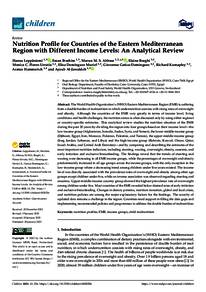Document
Nutrition profile for countries of the Eastern Mediterranean region with different income levels : an analytical review.
Contributors
Ibrahim, Eman., Author
Abbass, Marwa M. S., Author
Borghi, Elaine., Author
Flores-Urrutia, Monica C., Author
Muriel, Elisa Dominguez., Author
Gatica-Domínguez, Giovanna., Author
Kumapley, Richard., Author
Hammerich, Asmus., Author
Al-Jawaldeh, Ayoub., Author
Publisher
Children.
Gregorian
2023-01
Language
English
English abstract
The World Health Organization's (WHO) Eastern Mediterranean Region (EMR) is suffering
from a double burden of malnutrition in which undernutrition coexists with rising rates of overweight
and obesity. Although the countries of the EMR vary greatly in terms of income level, living
conditions and health challenges, the nutrition status is often discussed only by using either regional
or country-specific estimates. This analytical review studies the nutrition situation of the EMR
during the past 20 years by dividing the region into four groups based on their income level—the
low-income group (Afghanistan, Somalia, Sudan, Syria, and Yemen), the lower-middle-income group
(Djibouti, Egypt, Iran, Morocco, Pakistan, Palestine, and Tunisia), the upper-middle-income group
(Iraq, Jordan, Lebanon, and Libya) and the high-income group (Bahrain, Kuwait, Oman, Qatar,
Saudi Arabia, and United Arab Emirates)—and by comparing and describing the estimates of the
most important nutrition indicators, including stunting, wasting, overweight, obesity, anaemia, and
early initiation and exclusive breastfeeding. The findings reveal that the trends of stunting and
wasting were decreasing in all EMR income groups, while the percentages of overweight and obesity
predominantly increased in all age groups across the income groups, with the only exception in the
low-income group where a decreasing trend among children under five years existed. The income
level was directly associated with the prevalence rates of overweight and obesity among other age
groups except children under five, while an inverse association was observed regarding stunting and
anaemia. Upper-middle-income country group showed the highest prevalence rate of overweight
among children under five. Most countries of the EMR revealed below-desired rates of early initiation
and exclusive breastfeeding. Changes in dietary patterns, nutrition transition, global and local crises,
and nutrition policies are among the major explanatory factors for the findings. The scarcity of
updated data remains a challenge in the region. Countries need support in filling the data gaps and
implementing recommended policies and programmes to address the double burden of malnutrition.
Member of
Category
Journal articles

